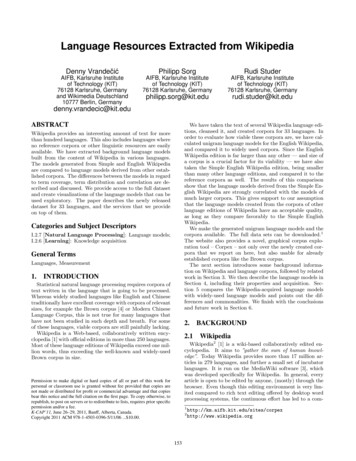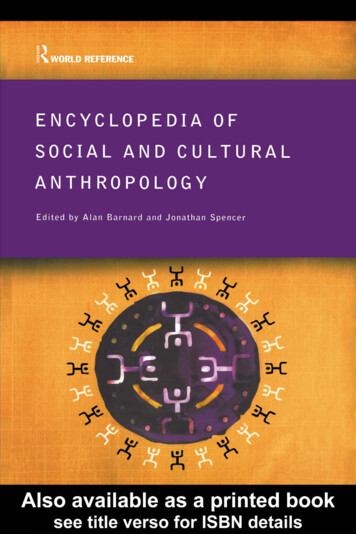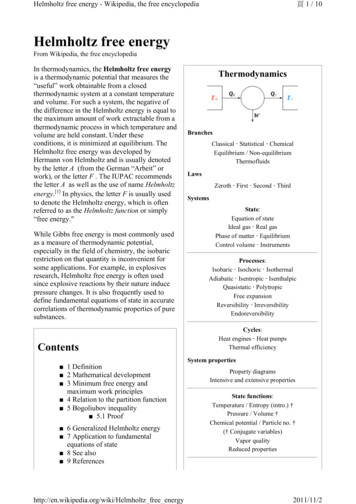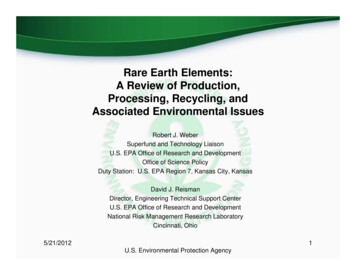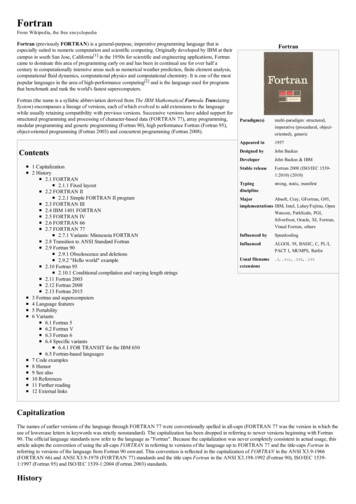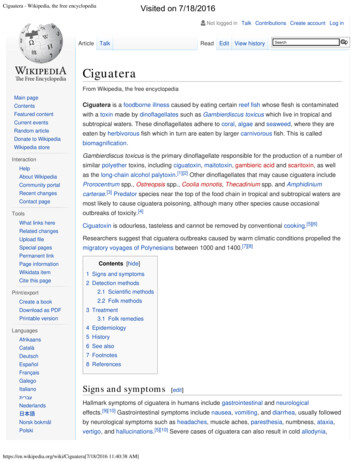
Transcription
Visited on 7/18/2016Ciguatera - Wikipedia, the free encyclopediaNot logged in Talk Contributions Create account Log inArticle TalkRead Edit View historySearchGoCiguateraFrom Wikipedia, the free encyclopediaMain pageContentsCiguatera is a foodborne illness caused by eating certain reef fish whose flesh is contaminatedFeatured contentwith a toxin made by dinoflagellates such as Gambierdiscus toxicus which live in tropical andCurrent eventssubtropical waters. These dinoflagellates adhere to coral, algae and seaweed, where they areRandom articleeaten by herbivorous fish which in turn are eaten by larger carnivorous fish. This is calledDonate to WikipediaWikipedia storeInteractionHelpbiomagnification.Gambierdiscus toxicus is the primary dinoflagellate responsible for the production of a number ofsimilar polyether toxins, including ciguatoxin, maitotoxin, gambieric acid and scaritoxin, as wellAbout Wikipediaas the long-chain alcohol palytoxin.[1][2] Other dinoflagellates that may cause ciguatera includeCommunity portalProrocentrum spp., Ostreopsis spp., Coolia monotis, Thecadinium spp. and AmphidiniumRecent changescarterae.[3] Predator species near the top of the food chain in tropical and subtropical waters areContact pagemost likely to cause ciguatera poisoning, although many other species cause occasionalToolsWhat links hereoutbreaks of toxicity.[4]Ciguatoxin is odourless, tasteless and cannot be removed by conventional cooking.[5][6]Related changesUpload fileResearchers suggest that ciguatera outbreaks caused by warm climatic conditions propelled theSpecial pagesmigratory voyages of Polynesians between 1000 and 1400.[7][8]Permanent linkPage informationContents [hide]Wikidata item1 Signs and symptomsCite this page2 Detection methodsPrint/exportCreate a bookDownload as PDFPrintable versionLanguages2.1 Scientific methods2.2 Folk methods3 Treatment3.1 Folk remedies4 EpidemiologyAfrikaans5 HistoryCatalà6 See alsoDeutsch7 FootnotesEspañol8 ReferencesFrançaisGalegoItaliano עברית NederlandsSigns and symptoms[edit]Hallmark symptoms of ciguatera in humans include gastrointestinal and neurological日本語effects.[9][10] Gastrointestinal symptoms include nausea, vomiting, and diarrhea, usually followedNorsk bokmålby neurological symptoms such as headaches, muscle aches, paresthesia, numbness, ataxia,Polskivertigo, and hallucinations.[5][10] Severe cases of ciguatera can also result in cold 7/18/2016 11:40:38 AM]
Visited on 7/18/2016Ciguatera - Wikipedia, the free encyclopediaPortuguêswhich is a burning sensation on contact with cold.[9] Neurological symptoms can persist andRomânăciguatera poisoning is occasionally misdiagnosed as multiple sclerosis.[11]РусскийSvenskaDyspareunia and other ciguatera symptoms have developed in otherwise healthy males andTiếng Việtfemales following sexual intercourse with partners suffering ciguatera poisoning, signifying that中文Edit linksthe toxin may be sexually transmitted.[12] Diarrhea and facial rashes have been reported inbreastfed infants of poisoned mothers, suggesting that ciguatera toxins migrate into breastmilk.[13]The symptoms can last from weeks to years, and in extreme cases as long as 20 years, oftenleading to long-term disability.[14] Most people do recover slowly over time.[15] Often patientsrecover, but symptoms then reappear. Such relapses can be triggered by consumption of nuts,seeds, alcoholic beverages, fish or fish-containing products, chicken or eggs, or by exposure tofumes such as those of bleach and other chemicals[citation needed]. Exercise is also a possibletrigger.[5]Detection methodsScientific methods[edit][edit]Currently, multiple laboratory methods are available to detect ciguatoxins, including liquidchromatography-mass spectrometry (LCMS), receptor binding assays, and neuroblastomaassays. Although testing is possible, in most cases, LCMS is insufficient to detect clinicallyrelevant concentrations of ciguatoxin in crude extracts of fish.Folk methods[edit]This section needs additional citations for verification.Please help improve this article by adding citations to reliablesources. Unsourced material may be challenged and removed.(October 2014) (Learn how and when to remove this template message)In Northern Australia, where ciguatera is a common problem, two different folk science methodsare widely believed to detect whether fish harbor significant ciguatoxin. The first method is thatflies are supposed not to land on contaminated fish. The second is that cats will displaysymptoms after eating contaminated fish. A third, less common testing method involves putting asilver coin under the scales of the suspect fish. If the coin turns black, according to the theory, itis contaminated.On Grand Cayman island the locals will test barracuda by placing a piece of the fish on theground and allowing ants to crawl on it. If the ants continue to move then the fish is deemed safeto eat.[citation needed]The validity of many of these tests has been scientifically rejected.[16] While animals such ascats do react to eating infected fish, such tests are difficult to execute properly and are sensitiveto org/wiki/Ciguatera[7/18/2016 11:40:38 AM]
Visited on 7/18/2016Ciguatera - Wikipedia, the free encyclopediaThere is no effective treatment or antidote for ciguatera poisoning. The mainstay of treatment issupportive care. There is some evidence that calcium channel blockers like nifedipine andverapamil are effective in treating some of the symptoms that remain after the initial sicknesspasses, such as poor circulation and shooting pains through the chest. These symptoms aredue to the cramping of arterial walls caused by maitotoxin[10][17][18][19] Ciguatoxin lowers thethreshold for opening voltage-gated sodium channels in synapses of the nervous system.Opening a sodium channel causes depolarization, which could sequentially cause paralysis,heart contraction, and changing the senses of hearing and cold. Some medications such asamitriptyline may reduce some symptoms, such as fatigue and paresthesia,[20] although benefitdoes not occur in every case.[21] Steroids and vitamin supplements support the body's recoveryrather than directly reducing toxin effects.Mannitol was once used for poisoning after one study reported symptom reversal.[10][22] Followup studies in animals[23] and case reports in humans[24] also found benefit from mannitol.However, a randomized, double-blind clinical trial found no difference between mannitol andnormal saline,[25] and based on this result, mannitol is no longer recommended.[9]Folk remedies[edit]Various Caribbean folk and ritualistic treatments originated in Cuba and nearby islands. Themost common old-time remedy involves bed rest subsequent to a guanabana juiceenema.[citation needed] Other folk treatments range from directly porting and bleeding thegastrointestinal tract to "cleansing" the diseased with a dove during a Santeríaritual.[citation needed] In Puerto Rico, natives drink a tea made from mangrove buttons, purportedlyhigh in B vitamins, to flush the toxic symptoms from the system.[citation needed] There has neverbeen a funded study of these treatments.An account of ciguatera poisoning from a linguistics researcher living on Malakula island,Vanuatu, indicates the local treatment: "We had to go with what local people told us: avoid saltand any seafood. Eat sugary foods. And they gave us a tea made from the roots of fernsgrowing on tree trunks. I don't know if any of that helped, but after a few weeks, the symptomsfaded away."[26]Senescent leaves of Heliotropium foertherianum (Boraginaceae), also known as octopus bush, aplant used in many Pacific islands as a traditional medicine to treat ciguatera fish poisoning,contain rosmarinic acid and derivatives, which are known for their antiviral, antibacterial,antioxidant and anti-inflammatory properties.[27] Rosmarinic acid may remove the ciguatoxinsfrom their sites of action, as well as being an anti-inflammatory.Epidemiology[edit]The current estimated global incidence annually is 20,000 to 50,000 people, though a largenumber of cases are believed to go unreported.[28]Due to the limited habitats of ciguatoxin-producing microorganisms, ciguatera is common only insubtropical and tropical waters, particularly the Pacific and Caribbean, and usually is associatedwith fish caught in tropical reef waters.[9] Exportation of reef fish, as well as tourism, oftenaccount for cases that develop in other regions.[28] Ciguatoxin is found in over 400 species 6 11:40:38 AM]
Visited on 7/18/2016Ciguatera - Wikipedia, the free encyclopediareef fish. Avoiding consumption of all reef fish is the only sure way to avoid exposure.[6]Imported fish served in restaurants may contain the toxin and produce illness which often goesunexplained by physicians unfamiliar with the symptoms of a tropical toxin.[6][29] Ciguatoxin canalso occur in farm-raised salmon.[30] Furthermore, species substitution, labeling a reef fish as anon-reef fish at restaurants and retail, can complicate efforts by consumers to avoid ciguatera.In 2007, ten people in St. Louis, Missouri developed the disease after eating imported fish.[31]In February 2008, the U.S. Food and Drug Administration (FDA) traced several outbreaks to theFlower Garden Banks National Marine Sanctuary in the northern Gulf of Mexico, near theTexas–Louisiana shoreline. The FDA advised seafood processors that ciguatera poisoning was"reasonably likely" to occur from eating several species of fish caught as far as 50 miles (80 km)from the sanctuary.[32]From August 2010 to July 2011, there were six outbreaks of Ciguatera Fish Poisoning in NewYork City. Outbreaks were linked to barracuda and grouper purchased at a fish market inQueens, New York.[33]In Q1 2012, two restaurants in Lanzarote, Canary Islands are thought to have been the sourceof ciguatera poisoning, leading to new fishing regulations issued 18 April 2012. The firstoutbreak was reported in February 2012. Diners suffered with vomiting, diarrhoea andabdominal pain several hours after eating amberjack. The second case was in early Aprilaffecting six people who live in Lanzarote and had all eaten amberjack at a local restaurant.[34]In April 2015, fourteen crew members of a potash ship were hospitalized in Saint John, NewBrunswick, Canada after consuming tropical fish obtained from international waters.[35] After theincident, Marine Catering Services issued a reminder to seafarers that the UK Food Act makes itillegal for crews to fish for food from their vessels.[36]History[edit]Ciguatera was first described by one of the surgeon's mates, William Anderson, on the crew ofHMS Resolution in 1774.[37]See also[edit]Algal bloomDinoflagellate (see "neurotoxins" and "red tide" under Ecology and fossils and see"phosphate" under Life Cycle)Red tideYessotoxinFootnotes[edit]1. Faust, MA and Gulledge RA. Identifying Harmful Marine Dynoflagellates.SmithsonianInstitution, Contributions from the United States National Herbarium. Volume 42:1-144. 2002.2. National Office for Harmful Algal Blooms, Ciguatera Fish Poisoning. Woods HoleOceanographic Institution.3. National Office for Harmful Algal Blooms, Ciguatera Fish Poisoning: Causative 7/18/2016 11:40:38 AM].
Visited on 7/18/2016Ciguatera - Wikipedia, the free encyclopediaWoods Hole Oceanographic Institution.4. FAO Agriculture and Consumer Protection. Ciguatera Fish Poisoning (CFP)In: MarineBiotoxins, Food and Agriculture Organization of the United Nations, Rome, 2004.5. a b c Swift A, Swift T (1993). "Ciguatera". J. Toxicol. Clin. Toxicol. 31 (1): 1–29.doi:10.3109/155636593090003716. abc. PMID 8433404.Schep LJ, Slaughter RJ, Temple WA, Beasley DM (2010). "Ciguatera poisoning: anincreasing occurrence in New Zealand". N. Z. Med. J. 123 (1308): 100–2. PMID 20173810.7. Rongo, Teina; Bush, Mark; Van Woesik, Robert (2009). "Did ciguatera prompt the lateHolocene Polynesian voyages of discovery?". Journal of Biogeography 36 (8): ll citation needed]8. Did fish poisoning drive Polynesian colonization of the Pacific?9. a b c d Isbister G, Kiernan M (2005). "Neurotoxic marine poisoning". Lancet. Neurol. 4 (4): 219–28. doi:10.1016/S1474-4422(05)70041-710. abcd. PMID 15778101.Clark RF, Williams SR, Nordt SP, Manoguerra AS (1999). "A review of selected seafoodpoisonings". Undersea Hyperb Med 26 (3): 175–84. PMID 10485519. Retrieved 2008-08-12.11. Ting J, Brown A (2001). "Ciguatera poisoning: a global issue with common managementproblems". Eur. J. Emerg. Med. 8 (4): 295–300. doi:10.1097/00063110-200112000-00009PMID 11785597.12. Lange W, Lipkin K, Yang G (1989). "Can ciguatera be a sexually transmitted disease?". J.Toxicol. Clin. Toxicol. 27 (3): 193–7. doi:10.3109/15563658909038583. PMID 2810444.13. Blythe D, de Sylva D (1990). "Mother's milk turns toxic following fish feast". JAMA 264 (16):2074. doi:10.1001/jama.264.16.2074b. PMID 2214071.14. Gillespie N, Lewis R, Pearn J, Bourke A, Holmes M, Bourke J, Shields W (1986). "Ciguatera inAustralia. Occurrence, clinical features, pathophysiology and management". Med. J. Aust. 145(11–12): 584–90. PMID 2432386.15. Pearn J (2001). "Neurology of ciguatera"doi:10.1136/jnnp.70.1.4. PMC 1763481. J. Neurol. Neurosurg. Psychiatr. 70 (1): 4–8. PMID 11118239.16. Park, D. L. (1994). "Evaluation of methods for assessing ciguatera toxins in fish.". Reviews ofEnvironmental Contamination and Toxicology 136: 1–20.17. Attaway D, Zaborsky O (1993). Marine Biotechnology. p. 8.18. Fleming L. "Ciguatera Fish Poisoning [1]". External link in title (help);19. Schlossberg D (1999). Infections of leisure. p. 13. ISBN 3-540-94069-3.20. Davis R, Villar L (1986). "Symptomatic improvement with amitriptyline in ciguatera fishpoisoning". N. Engl. J. Med. 315 (1): 65. doi:10.1056/NEJM198607033150115PMID 3713788.21. Hampton M, Hampton A (1989). "Ciguatera fish poisoning". J. Am. Acad. Dermatol. 20 (3):510–1. doi:10.1016/S0190-9622(89)80094-5. PMID 2918120.22. Palafox N, Jain L, Pinano A, Gulick T, Williams R, Schatz I (1988). "Successful treatment ofciguatera fish poisoning with intravenous mannitol". JAMA 259 (18): 2740–2.doi:10.1001/jama.259.18.2740. PMID 3128666.23. Mattei C, Molgó J, Marquais M, Vernoux J, Benoit E (1999). "Hyperosmolar D-mannitolreverses the increased membrane excitability and the nodal swelling caused by Caribbeanciguatoxin-1 in single frog myelinated axons". Brain Res. 847 (1): 50–8. doi:10.1016/S00068993(99)02032-6. PMID 10564735.24. Williamson J (1990). "Ciguatera and mannitol: a successful treatment". Med. J. Aust. 153 (5):306–7. PMID 2118229.25. Schnorf H, Taurarii M, Cundy T (2002). "Ciguatera fish poisoning: a double-blind randomizedtrial of mannitol therapy". Neurology 58 (6): 873–80. iki/Ciguatera[7/18/2016 11:40:38 AM].
Visited on 7/18/2016Ciguatera - Wikipedia, the free encyclopediaPMID 11914401.26. Dimock, Laura (June 2010). "Rescue mission for fading tongue". New Zealand EducationReview.27. Rossi, Fanny; Jullian, Valérie; Pawlowiez, Ralph; Kumar-Roiné, Shilpa; Haddad, Mohamed;Darius, H. Taiana; Gaertner-Mazouni, Nabila; Chinain, Mireille; Laurent, Dominique (2012)."Protective effect of Heliotropium foertherianum (Boraginaceae) folk remedy and its activecompound, rosmarinic acid, against a Pacific ciguatoxin". Journal of Ethnopharmacology 143 (1):33–40. doi:10.1016/j.jep.2012.05.045. PMID 2270615028. a b Marcus, Erin N., Ciguatera fish poisoning., retrieved 6 April 201529. Geller R, Olson K, Senécal P (1991). "Ciguatera fish poisoning in San Francisco, California,caused by imported barracuda"PMID 1812639. West. J. Med. 155 (6): 639–42. PMC 1003121.30. DiNubile M, Hokama Y (1995). "The ciguatera poisoning syndrome from farm-raised salmon".Annals of Internal Medicine 122 (2): 113–4. doi:10.7326/0003-4819-122-2-199501150-00006PMID 7992985.31. Bizarre fish poisoning sparks alarm32. "FDA Advises Seafood Processors About Ciguatera Fish Poisoning in the Northern Gulf ofMexico Near the Flower Garden Banks National Marine Sanctuary"(Press release). U.S. Foodand Drug Administration. 2008-02-05. Retrieved 2008-02-07.33. Centers for Disease Control and Prevention (CDC) (2013). "Ciguatera fish poisoning - NewYork City, 2010-2011"PMID 23364271. MMWR. Morbidity and mortality weekly report 62 (4): 61–5.34. Cliffe-Jones, Mike "Jules" (April 17, 2012). "Isolated Cases of Ciguatera Poisoning inLanzarote". Information Lanzarote (Information Lanzarote). Retrieved 31 October 2015.35. "Balsa 85 ID'd as ship in Saint John whose crew was hit by food poisoning". CBC NewBrunswick (CBC). CBC. 13 April 2015. Retrieved 31 October 2015.36. "Seafarers told no fishing!". The Sea (236) (Mission to Seafarers Limited). Jul–Aug 2015.37. Sanders, Lisa (April 5, 2010). "Fish Tale". New York Times. Retrieved 2010-04-10. "Theillness was first described in 1774 by a surgeon's mate on the crew of Captain Cook's SouthPacific exploration aboard the HMS Resolution. The crewman, John Anderson, documented thesymptoms described by several shipmates who had eaten a large fish caught in the tropicalwaters." (The New York Times incorrectly gives William Anderson's first name as John.)References[edit]Ciguatera fish poisoningCDCCenters for Disease Control and Prevention (CDC) (1993). "Ciguatera fish poisoning-Florida, 1991" . MMWR. Morbidity and mortality weekly report 42 (21): 417–8.PMID 8497243 .Centers for Disease Control and Prevention (CDC) (1998). "Ciguatera fish poisoning--Texas,1997" . MMWR. Morbidity and mortality weekly report 47 (33): 692–4. PMID 9733416 .Epidemiologic notes and reports ciguatera fish poisoning— Bahamas, Miami . MMWR July23, 1982;31(28):391-2Epidemiologic notes and reports ciguatera fish poisoning—Vermont . MMWR April 25,1986;35(16):263-4Ciguatera fish /18/2016 11:40:38 AM]
Visited on 7/18/2016Ciguatera - Wikipedia, the free encyclopediav·t·ePlankton[show]v·t·ePoisoning · Toxicity · Overdosing (T36–T65, 960–989)[show]Categories: Toxic effect of noxious substances eaten as foodThis page was last modified on 26 May 2016, at 06:25.Text is available under the Creative Commons Attribution-ShareAlike License; additional terms may apply. By using this site,you agree to the Terms of Use and Privacy Policy. Wikipedia is a registered trademark of the Wikimedia Foundation, Inc., anon-profit organization.Privacy policyAbout /18/2016 11:40:38 AM]DisclaimersContact WikipediaDevelopersCookie statementMobile view
May 26, 2016 · From Wikipedia, the free encyclopedia . The second is that cats will display symptoms after eating contaminated fish. A third, less common testing method involves putting a silver coin under the scales of the suspect f

